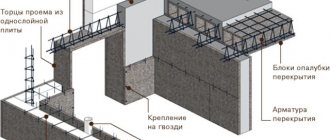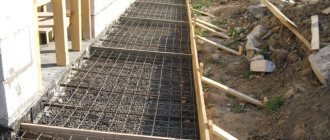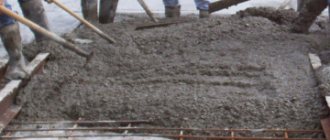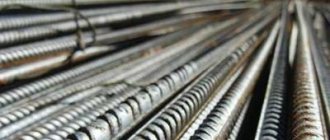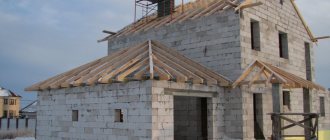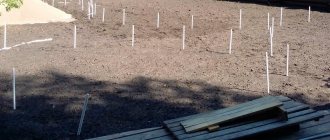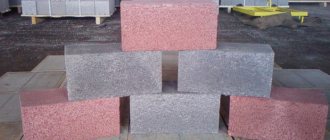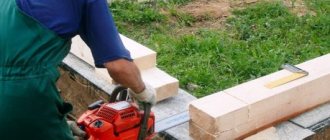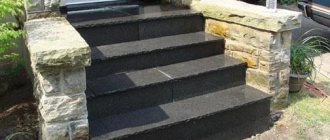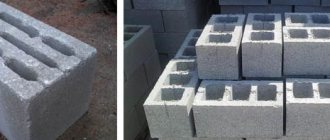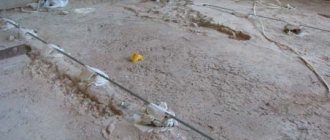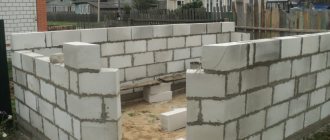Slag concrete
Laying concrete in formwork
Slag, ashes and ash and slag mixtures are widely used in the production of concrete. They successfully replace traditional aggregates of natural origin, such as sand, crushed stone or gravel, light and porous aggregates of artificial origin (agloporite, expanded clay and others), natural origin (tuff, pumice, as well as other types) or in combination with them.
The content of the article:
1. The use of ash and slag in the production of concrete.
2. Types, strength grades and main performance characteristics of concrete based on ash, slag and ash and slag mixture.
3.Production and use of concrete based on ash and slag in construction.
As well as light and porous aggregates of artificial origin (aggloporite, expanded clay and others), natural origin (tuff, pumice, as well as other types) or in combination with them.
The use of slag, ash and ash and slag mixtures in combination with cement binder makes it possible to ultimately obtain high grade concrete:
1. In terms of strength - M50... M500.
2. According to water resistance W2…W12.
3. According to frost resistance F50...F300, as well as the following types of concrete:
a) Light or heavy with the addition of ash instead of a certain part of the cement, as well as part of the aggregates and part of the cement.
b) Fine-grained concrete prepared with an ash and slag mixture, having a density of 1800 to 2200 kg/m³. The ash and slag mixture is used instead of natural fine sand.
c) Heavy concrete with combined aggregates, consisting of dense slag in combination with aggregates of natural origin or ash and slag mixture.
d) Lightweight concrete with combined aggregates consisting of ash and slag mixture, ash or porous slag together with natural or artificial porous aggregates.
e) Heat-resistant concrete consisting of combined fillers: for example, from an ash and slag mixture or dense slag in combination with fillers of natural origin.
f) Cellular concrete.
If you introduce the optimal amount of ash and slag mixture or ash into the concrete composition, this will improve a number of very significant operational properties, such as improved workability of concrete, high frost resistance, high strength, and will also reduce shrinkage and water permeability.
The use of ash in the composition of concrete does not adversely affect creep deformation, the modulus of elasticity of concrete of ordinary composition and shrinkage. The presence of ash in the concrete composition significantly increases the sulfate resistance of concrete and the corrosion resistance of reinforced concrete. Concrete made from slag and ash, as well as based on an ash and slag mixture, is commonly called ash and slag concrete and is widely used in various fields of construction.
Production and use of concrete from slag in construction
Ash and slag concrete is not used to cover the top layer of coatings in the construction of highways, shells of cooling towers and exhaust pipe outlets, bridge spans, hydraulic structures in those parts where they are most subject to alternating freezing and thawing. During the preparation of heavy concrete based on dense aggregates, ash added in the optimal amount in the following average amounts:
1. For 1 m³ of steamed concrete - 150 kg.
2. For 1 m³ of concrete that hardens without heat treatment (under natural conditions) - 100 kg.
Cement savings can reach up to 50-70 kg per 1 m³ of steamed concrete and up to 30-40 kg for concrete hardening without heat treatment. Ash is introduced into the concrete mass at the same time, instead of part of the cement, part of sand and crushed stone, without changing the accepted ratio between them. Natural crushed stone is replaced with slag in limiting ratios from 20 to 50%, while the grains of slag crushed stone are selected larger than 3 mm.
When determining the water consumption in concrete based on slag and ash (ash and slag concrete), the degree of water absorption of the aggregates used is taken into account. Figure No. 1. Consumption of ash and slag mixture depending on cement consumption and ash content in the ash and slag mixture
Consumption of ash and slag mixture
Number 1 indicates cement consumption at ash content of 16%, 2-24%, 3-30% and 4-35%.
Figure No. 2. Dependence of the strength of ash and slag concrete on the w/c concrete mixture for cement grade 300; 400 ; and 500.
Dependence of the strength of ash and slag concrete on W/C and cement grade
Figure No. 2 shows the dependence of the strength of ash and slag concrete on W/C and cement consumption, where 1 is cement grade M 300; 2-400 and 3-500. Heat treatment of products is carried out at maximum temperature (80...95 °C) when steaming concrete and 140...150 °C during dry heating. At such temperatures, the hydraulic properties of ash and slag materials are most pronounced.
The duration of isothermal heating must be at least 9 hours. The total duration is at least 14 hours, including the time required to raise the temperature and cool down - at least 14 hours. Thanks to the developed technology for manufacturing floor panels and walls based on ash and slag concrete, it is possible to achieve high quality surfaces of products, as well as significantly reduce the time of compaction of the mixture (up to 2-3 seconds).
This, in turn, allows you to avoid puttingty on the surfaces of products for painting, reduce the cost of products by up to 4% and improve working conditions in the workshop. Savings are achieved mainly by reducing cement consumption and by eliminating costs associated with finishing surfaces. Lightweight concrete mixtures that contain ash and slag materials have reduced delamination and increased air-holding capacity. Lightweight concrete mixtures are less sensitive to overloads and when transported via a belt conveyor.
Figure No. 3. Dependence of the strength of ash and slag concrete on the consumption of cement grade: 1-300; 2-400 and 3-500.
Dependence of the strength of ash and slag concrete on cement consumption
When ash is introduced into the composition of a lightweight concrete mixture, its viscosity in a static state increases, but this does not affect the conditions of its thixotropic liquefaction during vibration. Concrete mixtures with the addition of ash have good workability, fill molds easily and are compacted under the influence of vibration. Ash and ash and slag mixture of thermal power plants used in the production of expanded clay concrete, in order to reduce cement consumption and to save expensive artificial porous aggregates. It is also used to reduce the average density of lightweight concrete, to completely replace or reduce the consumption of dense sand.
Table No. 1. Characteristics of expanded clay concrete with ash as a fine aggregate
Compared to expanded clay concrete prepared with crushed expanded clay sand, the average density of structural and thermal insulating expanded clay concrete with ash is reduced by 50 kg/m³. In this case, the consumption of expanded clay is reduced by 0.4...0.6 m³ (taking into account the needs for crushing).
Table No. 2. Composition of heat-resistant concrete with the addition of ash
Ash and ash-and-slag mixtures are widely used as fillers and for the preparation of heat-resistant concrete using Portland cement with holding temperatures up to 1000 °C.
strivagon.ru
Cinder concrete walls
Monolithic infill and block walls are made from cinder concrete. They are quite durable, have low thermal conductivity, are fireproof, cheap and have a number of other positive properties. The thickness of such walls depends on climatic conditions.Cement, lime, gypsum, and clay can be used as binding materials for slag concrete. The most durable of them are the first two.
The filler is slag, clean, sorted on sieves with cells 40X40, 5X5 and 1x1 mm.
First, the slag is sifted on a sieve with cells of 40X40 mm, and then - 5X5 mm. What does not pass through the 5X5 mm sieve is considered large slag. The slag that has passed through this sieve is sifted on a sieve with 1X 1 mm cells. It is as if two fractions of slag are formed - large (not passing through a sieve with 5X5 mm cells) and small (not passing through a 1X1 mm sieve). 60-70% coarse and 30-40% fine slag are mixed with one or two binders.
To increase strength, the slag must be moistened several hours before preparing the concrete mixture. To prepare 1 m3 of slag concrete, 250 to 350 liters of water are consumed.
When preparing cinder concrete of a certain brand, you should take into account not only the amount of materials taken by volume, but also the brand of cement (Table 14).
The technology for preparing slag concrete is simple. Measure out large and small slag, shovel the mixture, add cement, shovel everything well again, moisten it with water and shovel it again until a homogeneous mass is obtained.
Slag concrete and cement are used for 1 hour 178
Cinder concrete with gypsum is prepared in small portions. They do it like this. Gypsum is added to the slag, the mixture is shoveled, water is added, everything is shoveled again and immediately used (use period 4-6 minutes).
Pressed (self-leveling) walls are constructed using formwork. Most often, adjustable formwork is made in stays (PO).
To prevent laitance from leaking between the seams, the formwork boards are adjusted to each other. If the walls are not plastered, then the formwork boards are planed. The thicker the formwork boards, the less often the racks need to be installed. Round posts with a diameter of at least 180 mm are cut to one edge, planed and boards are attached to the edge.
The racks should be placed strictly vertically at a distance of 1 m from each other and buried in the ground to a depth of at least 600-700 mm. For strength, they are fastened with struts. Between the boards and racks, slats or wedges are placed, which are removed when stripping.
Pressed walls can be monolithic or hollow. To create voids, liners are inserted into the concrete, securing them in the formwork. The shape and size of the liners can be varied, but they should all be slightly cone-shaped. Before inserting into the formwork, they are lubricated with machine oil or grease, lime paste or liquid clay, etc. Instead of lubricating, the liners can be wrapped in roofing felt, roofing felt, glassine or thick paper (all this is removed after removing the liners). Since the concrete in the formwork is filled with belts, the liners must be inserted into the previously left voids.
Sometimes, instead of liners, paper (cardboard) pipes of round or elliptical shape are made, as long as the walls are high or half as long. These pipes are left in the walls.
Usually they make two rows of voids, but it is better when there are three or five. After the walls have dried, these voids are filled with completely dry slag, ash, peat, etc. Slag concrete walls shrink greatly, as a result of which cracks appear in them. This can be avoided by inserting steel rods with a diameter of 4-6 mm into the cinder concrete at the rate of three to four rods per wall width. They are placed in several rows along the height of the walls in the following order: the first row is 50 mm above the insulating layer of the foundation, the second is under the window openings, the third is above the window openings, the fourth is at the bottom mark of the attic or interfloor floor beams.
Having installed the formwork and liners, prepare the slag concrete mass and immediately lay it in layers no more than 200 mm thick. Then the mass is carefully pierced with a spatula, a thin steel rod or stick (especially at the walls of the formwork, in the corners of the house and near the liners), and then compacted with a tamper.
A second layer is placed on the first layer, then a third, etc. Cinder concrete, which contains cement, should be watered with water for 10 days and covered with burlap, matting, straw or reed mats. Slag concrete on lime, gypsum and clay should not be watered, but only protected from rapid drying out and cracking (this should be done especially in windy weather).
The cinder concrete is removed from the formwork 2-3 days after pouring.
Concrete hardens completely in 28 days and dries in 2-3 months. After the voids have completely dried, it is recommended to fill them with dry materials (20 cm layers), compacting them well.
It is not recommended to seal window and door frames. It is better to make temporary boxes, the dimensions of which are 20 mm larger in height and width, and strengthen them in the formwork. When concreting, wooden plugs are placed on the sides of temporary boxes (two or three on each side). After the concrete has set, the temporary boxes are removed and permanent ones are installed, securing them with nails to wooden plugs. The gaps between the boxes and the walls are sealed with windows.
Walls made from individual concrete blocks or stones are preferred by many developers. Common dimensions of a whole stone: length - 390 mm, width - 190, height - 188 mm. The masonry can be solid or with voids that are filled with thermal insulation materials. To make stones, a mold is made, and slag concrete is prepared with a volumetric mass of 1400 to 1800 kg/m3.
Less thermally conductive and lighter materials are pumice and tuff.
Slag concrete: types, self-preparation of the solution
Slag concrete is widely used in private buildings due to a number of advantages and ease of working with the material. Due to the fact that the material is much lighter than ordinary concrete, its use reduces the load on the structure of the house while the thermal insulation properties are maintained at a fairly high level. Let's consider the main types of this group of products, their advantages and features of use.
Cinder concrete blocks have high performance properties
Overview of the main features of the material
To decide on the advisability of using such products, you need to know all the information about them in order to compare them with other options and draw the right conclusions (
Filling with slag concrete
To fill the walls of a building with cinder concrete, formwork with a height of no more than sixty centimeters is used. Panel formwork is used. The shields are attached to fixedly installed posts with a diameter of at least fifteen centimeters in increments of one and a half meters.
Pouring of slag concrete is carried out in layers of twenty centimeters with mandatory subsequent bayoneting and tamping. The formwork can be removed no earlier than after three days, but if the weather is dry and hot, then the period can be reduced to a day. Laid concrete needs maintenance. So, for ten days it is strictly forbidden for the concrete body to be exposed to direct rays of the sun, and in dry and hot weather it needs to be moistened from time to time.
Thermal conductivity of slag concrete
To increase thermal conductivity in walls under construction, it is allowed to create voids by filling them with foam pieces, old paper or even lighter concrete.
Do not forget that this method of increasing the thermal conductivity of walls weakens their strength. In this case, it is necessary to increase the strength of slag concrete.
Plastering work can only be carried out after twenty-eight days have passed from the moment the concrete was poured. To give the wall additional strength qualities and a more aesthetic appearance, you can line the walls with brick.
In order to speed up the process of constructing cinder concrete walls, you can use ready-made cinder concrete blocks, either self-made or factory-made. To make blocks, wooden collapsible molds are used. Drying time for blocks is approximately three weeks. Their use will reduce construction time and begin plastering work the next day after the completion of wall laying.
Cinder concrete walls are labor-intensive to construct, but they allow you to save money and remove unnecessary waste.
Slag concrete and slag-alkaline concrete: raw materials and methods of their production
During the construction of low-rise buildings, low loads on the walls make it possible to significantly expand the range of materials from which wall and other building structures can be erected. This also applies to slag concrete, which, although it belongs to the category of heavy concrete, has much less weight than its counterparts using traditional aggregates - gravel and crushed stone of natural origin. A full-fledged binder component - slag-alkali cement, which can qualitatively replace traditional Portland cement, can be made from ground slag.
Requirements for slag
Slag is a by-product, which is an alloy of various types of oxides formed during high-temperature processing of raw materials. Depending on the composition of the raw materials, the slag can be basic or acidic.
Not all raw materials are suitable for the production of slag concrete. The main requirement for slag is the absence of chemical compounds in the alloy oxides that negatively affect the characteristics of the resulting building material. Special requirements are also imposed on the purity of the slag. It must be free from soil, clay, ash and other debris.
Slag from the metallurgical and fuel industries is used to produce slag concrete.
The use of metallurgical slag makes it possible to obtain more durable concrete. Of the fuel industry slags, the most suitable raw materials are the combustion products of anthracite rocks. The combustion products of brown coal are unsuitable for concrete production, since they contain impurities attached to the slag on the basis of unstable bonds.
It is advisable that during storage the slag is moved from place to place about three times. This measure makes it possible to achieve a high degree of purification of the material from impurities of lime and sulfur.
Slag intended for concrete production must be stored outdoors for at least six months. During this period, the material acquires the necessary properties, and under the influence of precipitation it is freed from harmful components.
Slag remains suitable for the production of slag concrete as long as its crystalline structure is preserved and signs of decay do not appear, which occur when one compound of the material changes to another under the influence of moisture and gases in the air. New connections have a larger volume than the original ones, so this transition is accompanied by cracking and destruction of slag pieces.
Features of making slag concrete
Depending on the grain size, slag for slag concrete is divided into crushed stone with a fraction of 5-40 mm, and sand with granules up to 5 mm. The use of slag sand increases concrete properties such as strength and density. Thanks to the use of slag crushed stone, lighter concrete with high thermal insulation properties, but lower strength characteristics is obtained.
To prepare slag concrete, two types of sieves are used: with large (40 x 40 mm) and small (5 x 5 mm) cells.
- To make external walls for concrete, take 7 parts of large and 3 parts of small slag.
- For internal walls, the proportion of fractions will be slightly different: 6 parts of large grains and 4 parts of small ones.
The strength of slag concrete can be increased by replacing a fifth of the finest fraction with ordinary sand and excluding the largest slag grains from the mixture.
To reduce the cost of a slag concrete structure, it is possible to use a combination of two binding components in its composition: cement and clay, cement and lime. The optimal proportions of binder components in slag concrete: cement - no less than 2/3 of the volume of binder, lime - no more than 1/3.
Additions of clay and lime not only reduce the cost of construction, but also make the walls drier and warmer. Lime slag concrete, the binder of which consists of 1/3 lime and 2/3 clay, hardens much longer than cement concrete, but in the future it has higher strength characteristics.
Before installing the floors, at least three months must pass from the time of construction of the walls made of lime slag concrete. Such walls must begin to be erected at the beginning of the warm period of the year in order to have time to complete the work before the onset of frost.
Lime may not be added, but in this case the mixture will not have sufficient plasticity and it will be impossible to mix it until a homogeneous color of the mass is formed.
The quality of mixing has a significant impact on the load-bearing capacity of building structures made of slag concrete.
The sequence of preparing slag concrete with your own hands is similar to the production of traditional building material:
- in a dry state, sand, cement and slag are mixed, which are pre-moistened;
- add clay or lime dough, this component helps to increase the plasticity of the mixture;
- pour water.
The use of slag concrete in the construction of various building structures
Slag concrete is one of the cheapest building materials today. Not only walls are made from cinder concrete, but also reinforced floor slabs. If the entire house is constructed from lightweight materials, then it is also possible to use slag concrete for the foundation and floor.
For the construction of walls, monolithic technology with adjustable formwork can be used. But ready-made wall and foundation blocks made of slag concrete are becoming increasingly popular.
Slag concrete is classified by grade. Grade 10 is used mainly for thermal insulation. Non-load-bearing structures are erected from slag concrete grades 25 and 35; grade 50 is used for the manufacture of reinforced lintels, internal and external load-bearing walls.
The main advantage of slag concrete is its lower specific gravity compared to ceramic or silicate bricks. This property allows you to reduce the load on the foundation and other supporting structures of the building. Large dimensional parameters of the blocks help reduce time and material costs for their installation. Cinder blocks are convenient for transportation.
The disadvantages of cinder concrete blocks include their slow hardening. A month after production, this material acquires only half of its brand strength.
Full compliance with all the characteristics laid down in this brand for cinder concrete blocks occurs approximately a year after their manufacture.
Walls made of slag concrete are hygroscopic and easily absorb water, so the roof of such a structure must have overhangs of at least 500 mm. It is necessary to protect cinder concrete elements from moisture within 2-3 days after their production.
Cinder concrete grade 10 has the highest thermal conductivity. If you want to prepare a material with increased thermal insulation yourself, add lime or gypsum to the binder.
Features of slag-alkaline concrete
High prices for Portland cement have led to a search for cheaper types of binder components. One of the most interesting finds is slag-alkaline cement. The history of its use began in Germany at the beginning of the nineteenth century, and in modern conditions it is used on construction sites all over the world. The creation of such cements became possible thanks to the establishment of the astringent properties of alkali metal compounds, which include lithium, sodium, potassium, rubidium, and cesium.
Slag-alkali cement is a high-strength binder consisting of ground slag and any alkali - liquid glass, soda and others.
Based on slag-alkali cement, reinforced concrete elements with increased resistance to chemically aggressive substances are produced. In their manufacture, fillers contaminated with clay inclusions can be used.
Slag-alkaline concrete is indispensable for the construction of massive objects. This is due to the fact that during the manufacture of large elements from concrete using Portland cement, a significant amount of heat is released, and the temperature of the structure can reach 80°C. If a concrete object cools too quickly, strain cracks may form. The use of slag-alkaline concrete makes it possible to avoid this problem.
The most widely used is slag-alkali cement based on ground metallurgical slag and alkali metal compounds, in which calcium hydrosilicates are predominant, and hydroaluminosilicates are auxiliary.
Advantages of concrete based on slag-alkali cement
- The use of concrete based on slag-alkali cement makes it possible to obtain structures with fewer capillary pores than when using conventional concrete based on Portland cement. This property significantly reduces water absorption and increases the frost resistance of concrete, which contributes to an increase in the performance qualities of the building structure.
- Corrosion of reinforcement in slag-alkaline concrete proceeds much slower than in traditional material.
- The strength of concrete using slag-alkaline binder reaches 130 MPa.
- The concrete mixture is perfectly laid, and the manufactured elements are well processed.
- In the first day, the material gains about 30% strength.
- Such concretes are resistant to sea water and some other aggressive environments - acids, chlorides, sulfates.
Thanks to the ability to control the properties of slag-alkali cement at different stages of structure formation, it has become possible to obtain binders with special properties: heat- and frost-resistant, with increased corrosion resistance, non-shrinkage, with a high hardening rate, cementing.
Composition of possible slag concrete mixtures
| Brand of cinder concrete | Volume composition (in parts) | Volume weight | ||||
| Cement 400 | Lime or clay | Sand | Fine slag | Coarse slag | ||
| 10 | 0,9 | 2 | 1 | 5 | 12 | 700 |
| 10 | 0,9 | 0,7 | 1 | 3 | 8 | 1100 |
| 25 | 1 | 1 | 2 | 6 | 12 | 900 |
| 25 | 0,9 | 0,5 | 2 | 3 | 5 | 1300 |
| 35 | 1 | 0,8 | 3 | 6 | 8 | 1100 |
| 35 | 0,9 | 0,3 | 2 | 3 | 3 | 1500 |
| 50 | 1 | 0,6 | 3 | 6 | 5 | 1300 |
www.navigator-beton.ru
Composition of slag concrete
To make slag concrete, fuel slag is used as a filler, and in the presence of metallurgical production, metallurgical slag is used. Slag, being very light (compared to crushed stone), has quite good strength indicators. Its cost price is approximately two times cheaper than clay brick, and its thermal conductivity is significantly superior to it. If technology is not violated during the work, slag concrete structures can last quite a long time - at least 50 years.
Most often, slag resulting from burning coal is used to make concrete, because They are more often found on the farm than metallurgical ones, but in terms of strength characteristics they are much weaker. The best slags among fuels are those obtained from the combustion of anthracite. They are the most durable and resistant. The slag resulting from the combustion of brown coal and coal near Moscow contains a large amount of impurities, which is why it is better not to use it in construction work. The slag produced during the combustion of other types of coal has intermediate qualities and can be used in construction. When choosing slag for preparing concrete, one should not allow the presence of impurities (clay, garbage, ash, etc.). The presence of unfired clay particles must be minimized. For this purpose, the slag is kept outside for at least one year to be washed with rainwater.
The strength and thermal conductivity of slag concrete are directly affected by the granulometric composition. Concrete must have a certain percentage composition of large and small granules (particles). When the percentage of large particles in concrete is very high, this significantly reduces its strength qualities and thermal conductivity, and the presence of small particles improves these qualities.
For the construction of external walls, slag with a predominance of large particles is always used, and internal walls are built from slag concrete with a predominance of small particles. The size of concrete particles for internal walls should not exceed 10 mm.
Slag concrete: how to make it yourself
Slag concrete mixtures are deservedly popular not only in industrial, but also in private low-rise construction. This is due to the characteristics of this material. Slag added to concrete is obtained as a secondary material in the metallurgical industry.
For a long time, granular material was considered simply waste, but world practice has proven its feasibility for use in construction. Slag concrete is lighter than sand and gravel and is distinguished by its durability, resistance to temperature fluctuations, and sound insulation properties.
It is the metallurgical material mixed with cement that has the greatest strength. Lime, gypsum or even clay can also act as a binding agent. Two types of granulated slag are actively used:
- with small grains (0.5-1.5 mm) – the result is fairly heavy, high-strength concrete with good thermal conductivity;
- with large grains (20-30 mm) - concrete is lighter, provides good thermal insulation, but is slightly less durable.
It is not recommended to use varieties larger than 6 mm, since the durability of such concrete will be unsatisfactory. It is preferable to replace finer fractions with sand. Slag for construction must be as clean as possible, without admixtures of clay, soil, or organic elements.
Considering the properties of concrete with different fractions, to create external walls, large and small grains are often mixed in a ratio of 7:3, respectively. For internal partitions, you can take one more fine slag. If you want to get the most durable mixture after hardening, it is advisable to completely remove the 12 mm fraction and replace 20% of the finest slag with sand.
How to prepare cinder concrete
Before starting to prepare the mixture (about a few hours), it is necessary to moisten the slag with water to improve the durability of the future concrete. Next, you need to mix the components in one of the above proportions and mix well. After adding water, the solution should be kneaded until smooth. To obtain an average grade of concrete, you can use 4-5 parts of slag (fractional mixture), 2 parts of cement and 2 parts of sand.
It is advisable to use the finished mass within an hour, the maximum processing time is 1.5 hours. A cheaper solution can be made by mixing cement with lime in a 3:1 ratio. The walls of the house can be erected using the cast-in-place method (monolithic structure) or from prepared cinder blocks.
postroika.com.ua
Features of making slag concrete with your own hands
The latter type is characterized by a small diameter and is an indispensable element for arranging partitions. With its help, the foundations of buildings are often created. Cinder blocks made of heavy and light components are widely used in the construction industry.
It is able to retain heat indoors, weighs relatively little, but cannot boast impressive density. Heavy structures have excellent strength characteristics and high weight. Their resistance to various impacts and loads is at a high level. In addition to the traditional version, slag concrete can be offered in the form of slabs. Such structures deserve special attention, because they are created on the basis of cinder concrete with a grade of at least M. A steel mesh with cells of 10 by 10 centimeters is used as a reinforcing element.
The role of the binding component is played by a cement mixture of a grade no less than M. It is relatively easy to create a cinder concrete block with your own hands.
Features of mixtures for domestic use
Knowing about the basic subtleties of the composition and proportions, as well as finding a step-by-step guide, you can solve such a problem in a short period of time. First you need to prepare special equipment and materials. These include:. Also, small installations for mass production of blocks are available in construction hypermarkets, which increase production volumes several times. As for stationary equipment, it has enormous power and operates automatically.
But for private purposes, purchasing such systems is not practical.
In turn, you can create a small concrete block press or machine for creating concrete yourself. Having delivered all the necessary tools and materials to the site, you can begin the production of cinder blocks.
Leveling the subfloor while simultaneously insulating it allows you to make a lightweight expanded clay concrete screed. It’s not difficult to do it yourself, the main thing is to maintain the correct proportions of the mixture. This will require the same components as for the preparation of ordinary concrete, only expanded clay, the same expanded clay, will serve as a coarse aggregate instead of crushed stone.
First you need to mix the solution by first preparing the slag and sifting it through a fine sieve. Also at this stage you need to divide it into two fractions - large and small. The last fraction should be twice as large, which will have a positive effect on the strength properties. Finally, all that remains is to dry the material and wait for final hardening.
